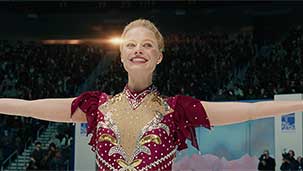That you are Canadian, and that you once worked with Nancy Kerrigan are both fairly interesting facts that are verifiable and largely uncontroversial—which isn’t something you can say about much that occurs in the film I, Tonya.
This isn’t necessarily a problem. It becomes clear early on that I, Tonya isn’t about the truth of a single event, rather about how competing narratives can create realities that contradict one another. That the events of I, Tonya run parallel to the emergence of cable news as a ubiquitous presence in American life is not a coincidence.
You and the filmmakers obviously went to a great deal of trouble to recreate Harding’s most iconic on-ice moments. I watched her skate back in the day and also revisited it on youtube after seeing the film—and the degree of authenticity you achieve is extraordinary. But then the film makers (seemingly intentionally) broke that veneer of credibility with several scenes in which it was overtly obvious that Margot Robbie’s face was CGI’d onto the stand in.
Oddly enough, that choice works remarkably well—much the same way the fourth wall-breaking asides by various characters felt appropriate to the tone of the film. This isn’t a documentary (or even a mockumentary), instead it puts forward a sort of theatrical reality, a reality coloured, often vividly, by the various narrators’ self serving worldviews. Something that seems exactly right for something as heightened and operatic as the world of figure skating.
In 1994, Nancy Kerrigan—an American figure skater preparing for the upcoming Winter Olympics in Lillehammer—was injured in an assault that was clearly intended to remove her from competition. Very early on it became clear that the attack originated somewhere within the small group of people that surrounded Kerrigan’s long-time rival Tonya Harding. What was not known immediately was whether or not Harding herself had knowledge of, or was directly responsible for, the attack.
I, Tonya depicts two wildly different versions of those events. It’s the Rashomon of figure skating. The two principal versions depicted (with occasional editorial commentary from supporting players) are those of Tonya and her husband Jeff Gillooly. But this isn’t an exercise in verite, or even an attempt at dramatic recreation. Instead I, Tonya seeks to echo the kind of confused, intensely contradictory narratives that are common in the contemporary media landscape.
This is less a film about a particular event than it is about how perceptions are shaped by whatever drives ratings and satiates our collective desire for tawdry stories about people who inhabit a parallel universe. Harding was a perfect foil for this kind of media exploitation: a child of a broken marriage and harried by a monstrous mother and an abusive husband (according to her, anyway), she still managed to rise to national prominence as one of the best figure skaters in the world. But as quickly as she became a hero, the contrast between her and the image of beauty the figure skating world preferred became fatally problematic. A short, powerfully-built woman from the wrong side of the tracks who snuck cigarettes between programs and made her own costumes was a natural antagonist for the slim, lithe, pristine princess that the figure skating elite wanted as their standard bearer.
None of this abrogates any responsibility for the role Harding may (or may not) have played in the crime. But however complicit she may have been, it’s hard to say the punishment fits the crime. The media coverage she suffered through makes it impossible to discern whether there was a fair and just response to her crimes. Harding was vilified and parodied and forced into a kind of exile that few of us could survive.
Tonya Harding was a remarkable athlete, and your work in recreating her accomplishments is to be commended. What you couldn’t do was show the world all the moments, bad and good, that led to those four minutes of glory. And more importantly, what came after.
Sincerely,

Tim







